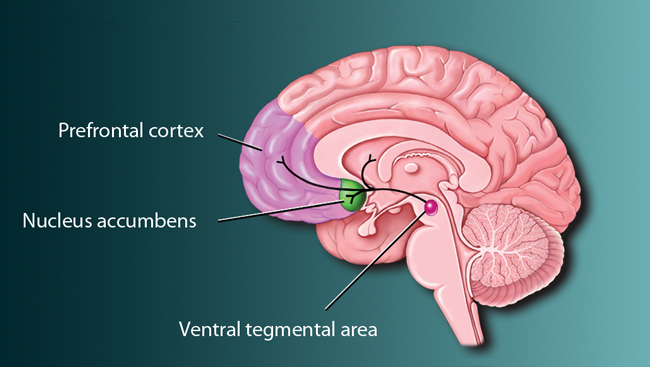Animal Research Success: Drug Addiction
- Published9 Mar 2012
- Reviewed9 Mar 2012
- Author Emily K. Dilger, PhD
- Source BrainFacts/SfN
Drug addiction is characterized by a pathological desire for drugs at the expense of other activities that persists despite adverse consequences. If continued, drug abuse can alter the structure and chemical makeup of the brain and become a true disorder.

Scientists are not certain about all the structures involved in the human brain reward system. But they do know that a central group of structures is common to the actions of all drugs. Drugs can hijack the brain systems that control pleasure.
Animal research has helped scientists better understand how repeated drug use changes the brain, resulting in new treatments for addiction. After scientists found a chemical that could block the effects of opioids in guinea pigs, the Food and Drug Administration (FDA) approved the medication naloxone to treat opioid dependence. Naltrexone works by preventing opioids from stimulating neurons, thereby preventing the user from feeling the effects of the abused drug. Other medications found through animal research, which could potentially help people avoid drug abuse or help recovered addicts prevent relapse, are in development or undergoing clinical trials.
How do scientists use animals in addiction research? Their first step was to determine whether other animals (besides humans) could become addicted. In an experiment with rats, scientists found that when the animals were given free access to the same drugs that humans become addicted to, they, too, will seek and take the drug compulsively. Further studies helped scientists understand the regions in the brain that are involved in addiction – initially, the reward pathway, especially the dopamine neurons in the area of the ventral tegmental area which communicates with the nucleus accumbens. This pathway is also activated by natural rewards such as food, water, and sex, but drugs of abuse are able to hijack the system. Further research helped scientists understand how addictive drugs act to overtake the reward system – by mimicking or blocking the function of neurotransmitters.
Research also has shown that drugs of abuse can affect systems concerned with learning and memory. As a result, cues or habits associated with drug use can elicit a craving for the drug in an addict's brain, even long into abstinence. Today, scientists are discovering how changes in the brain lead to the compulsive drug taking that characterizes addiction, and they are beginning to understand why some individuals are more likely to become addicted than others.
All this research depends on animal models. Unfortunately, there is a shortage of adequate animals models for the study of drug addiction issues. In fact, this shortage may be partially to blame for the absence of more useful therapeutics. New treatments for addiction will depend upon the development of new ways to study the disorder.
CONTENT PROVIDED BY
BrainFacts/SfN
Also In Archives
Trending
Popular articles on BrainFacts.org


















